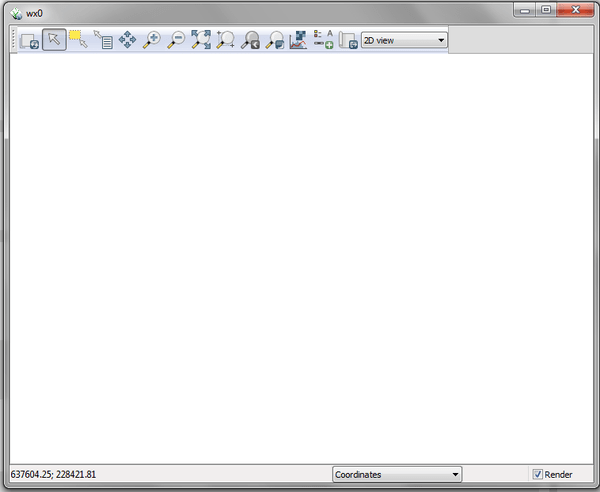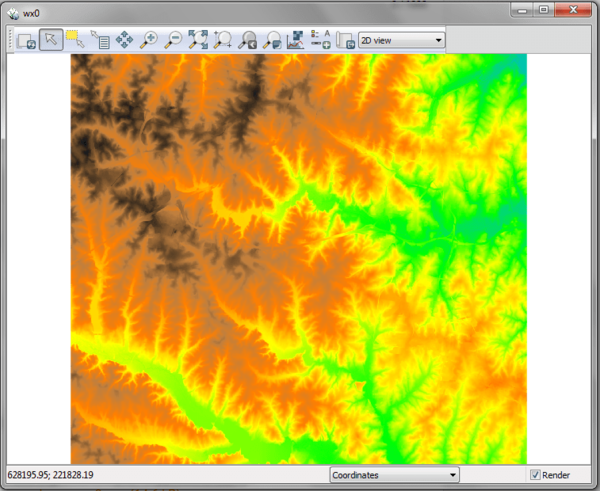
Note: This document is for an older version of GRASS GIS that will be discontinued soon. You should upgrade, and read the current manual page.
NAME
d.mon - Controls graphics display monitors from the command line.KEYWORDS
display, graphics, monitorsSYNOPSIS
Flags:
- -l
- List running monitors and exit
- -p
- Print name of currently selected monitor and exit
- -c
- Print commands for currently selected monitor and exit
- -g
- Print path to support files of currently selected monitor and exit
- -s
- Do not automatically select when starting
- -r
- Release and stop currently selected monitor and exit
- -t
- Disable true colors
- -u
- Open output file in update mode
- Requires --overwrite flag
- -x
- Launch light-weight wx monitor without toolbars and statusbar
- Requires 'start=wx0-7'
- --overwrite
- Allow output files to overwrite existing files
- --help
- Print usage summary
- --verbose
- Verbose module output
- --quiet
- Quiet module output
- --ui
- Force launching GUI dialog
Parameters:
- start=string
- Name of monitor to start
- Options: wx0, wx1, wx2, wx3, wx4, wx5, wx6, wx7, png, ps, html, cairo
- stop=string
- Name of monitor to stop
- Options: wx0, wx1, wx2, wx3, wx4, wx5, wx6, wx7, png, ps, html, cairo
- select=string
- Name of monitor to select
- Options: wx0, wx1, wx2, wx3, wx4, wx5, wx6, wx7, png, ps, html, cairo
- width=value
- Width for display monitor if not set by GRASS_RENDER_WIDTH
- Default value: 720
- height=value
- Height for display monitor if not set by GRASS_RENDER_HEIGHT
- Default value: 480
- resolution=value
- Dimensions of display monitor versus current size
- Example: resolution=2 enlarge display monitor twice to 1280x960
- bgcolor=name
- Background color
- Either a standard color name, R:G:B triplet, or "none"
- Default: white
- output=name
- Name for output file (when starting new monitor)
- Ignored for 'wx' monitors
Table of contents
DESCRIPTION
d.mon allows the user to start, select, list, release, and stop available graphics monitors.Starting a monitor
In order to display on-screen GRASS graphics, the user must start and select a graphics monitor. By default, the start command actually runs two commands, to both start and select whatever monitor is named by the user. The user can get a list of running monitors by setting the -l flag on the command line. Note that some monitor drivers use environment variables or the specific driver documentation.When a monitor is started, it is therefore also (automatically) selected for output, unless the -s flag is set by the user; the user can also explicitly select a monitor that has been started.
The desired monitor should be started once and need not be restarted unless it is stopped for some reason. A monitor may continue to run for any length of time, even when no GRASS session is being run.
Stopping a monitor
A graphics monitor has two different types of status: monitor program not running, and monitor running. A monitor that has been started and/or selected will be listed as running; a monitor that has been stopped (or not started) will be listed as not running. The -l flag will list all currently running monitors.Selecting a monitor
When the user starts a monitor, it is also (automatically) selected for graphics output unless the user sets the -s flag. In order to use (direct graphics output to) a monitor, the user must select that monitor for use, either by simply starting the monitor without the -s flag or by explicitly selecting the monitor for output. Only running monitors can be selected for graphics output.The user can run multiple graphics monitors by simply starting each of the graphics monitors the user wishes to direct output to.
Releasing (unselecting) a monitor
Currently selected a monitor can be released by -r flag.NOTES
d.mon is designed for interactive use. If non-interactive use is needed (e.g., in a script) set GRASS_RENDER_IMMEDIATE=png (or =cairo) and use the related environment variables to control output size etc.EXAMPLES
wx0 monitor
To start the interactive wxGUI map display, rund.mon start=wx0

Figure: The initialization of display monitor wx0
g.region raster=elevation -p d.rast map=elevation

Figure: The display wx0 showing an elevation raster map
CAIRO file renderer monitor
A CAIRO monitor can be started (and selected) byd.mon start=cairo output=out.pdf
List running monitors
To list the currently running monitors, used.mon -l List of running monitors: wx0 cairo
Show currently selected monitor
To identify the currently selected monitor, used.mon -p cairo
Switching between monitors
To switch back to interactive display mode, here to an earlier started and still running wxGUI monitor, used.mon select=wx0
Stopping a monitor
To close the wxGUI monitor, rund.mon stop=wx0
SEE ALSO
d.erase, d.redraw, d.rast, d.vect, d.frameSee also list of variables for rendering, display drivers
AUTHOR
Martin Landa, OSGeoREL, Czech Technical University in Prague, Czech RepublicSOURCE CODE
Available at: d.mon source code (history)
Latest change: Thursday Feb 03 11:10:06 2022 in commit: 547ff44e6aecfb4c9cbf6a4717fc14e521bec0be
Note: This document is for an older version of GRASS GIS that will be discontinued soon. You should upgrade, and read the current manual page.
Main index | Display index | Topics index | Keywords index | Graphical index | Full index
© 2003-2023 GRASS Development Team, GRASS GIS 8.2.2dev Reference Manual